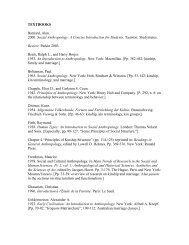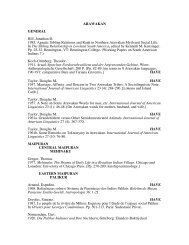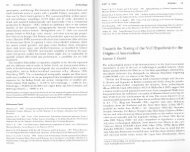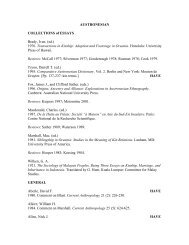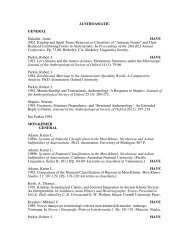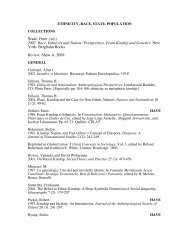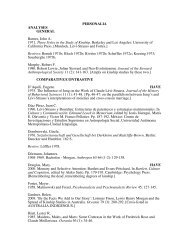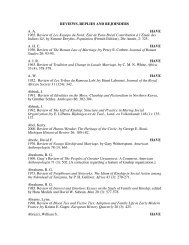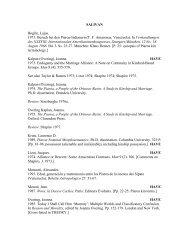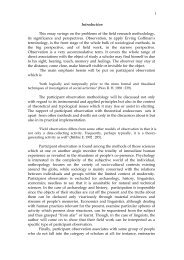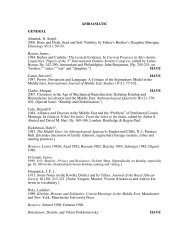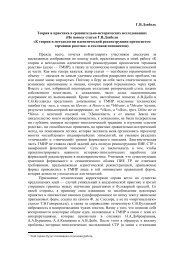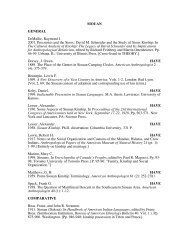On The Heterogeneity of Social Development - Kinship Studies
On The Heterogeneity of Social Development - Kinship Studies
On The Heterogeneity of Social Development - Kinship Studies
Create successful ePaper yourself
Turn your PDF publications into a flip-book with our unique Google optimized e-Paper software.
21<strong>The</strong> conceptual separation <strong>of</strong> time and space dates back to theNewtonian physics wherein time was absolutely defined as flowingindependently from physical and social processes and unsusceptibleto change (Adam B. 1990: 50). This understanding was later refutedby Einstein's theory <strong>of</strong> relativity, which echoes the concepts <strong>of</strong>primitive cosmology. According to it, physical reality appears as the"four-dimensional existence" and not, as in Newtonian mechanics "theevolution <strong>of</strong> a three-dimensional existence" (Einstein A. 1993 (1920):150; italics in the original). <strong>The</strong> applicability <strong>of</strong> the Newtonian theoryis confined to the situations when gravitational fields are "weak" and"all masses move with respect to the co-ordinate system with velocitieswhich are small compared with the velocity <strong>of</strong> light" (Einstein A.1993(1920): 102).While sociologists have recognised the theoretical importance <strong>of</strong>the advances <strong>of</strong> natural sciences in the field <strong>of</strong> time-space ontology,their practical implementation within social sciences remainsproblematic."Whilst Einstein's work has no direct practical application for socialscience, we need to take note <strong>of</strong> it at the level <strong>of</strong> theory since most socialscientists understand natural time exclusively through the conceptualframework <strong>of</strong> Newtonian physics as absolute, objective, spatial and clocklike"(Adam B. 1990: 56).It is essential that the theory <strong>of</strong> relativity was produced only dueto the inclusion <strong>of</strong> the social context into the physical system <strong>of</strong>measurement. Time being conceived as dependent on a certain point<strong>of</strong> observation makes the whole Einstein's theory sociological parexcellence. <strong>On</strong>ly for the social actor can time be intrinsically fusedwith space. Moreover if light is assumed to possess a velocity whichforms a barrier between the ‘time versus space’ reality and ‘timespace’reality and humans are believed to live according to the firstmodel, then the question arises as to how did they manage tocalculate this velocity. With a pardoned vulgarity, one might say thatman should have chanced to be at the source <strong>of</strong> light before the latterstarted to move, waited until the light was emitted, outrun the lightwith a sort <strong>of</strong> stop-watch in his hand and stayed waiting for the lightto finally arrive. While the human body as yet can not enjoy a ridewith a speed higher than the velocity <strong>of</strong> light, human cognition surelycan significantly exceed the latter. A conclusion suggests itself thatsocial scientists deal, as a matter <strong>of</strong> fact, with the physics <strong>of</strong> thehighest velocities - only they face up with these processes, so to say,au milieu du visage. <strong>The</strong> backwardness <strong>of</strong> the measurement system <strong>of</strong>social sciences in comparison to the measurement system <strong>of</strong> naturalsciences is, then, quite understandable and proceeds from thequalities <strong>of</strong> their object. Husserl once noted that, in the case <strong>of</strong>natural sciences achievements, one deals with



